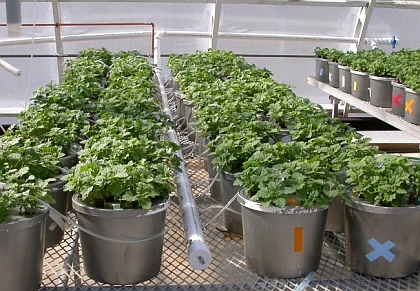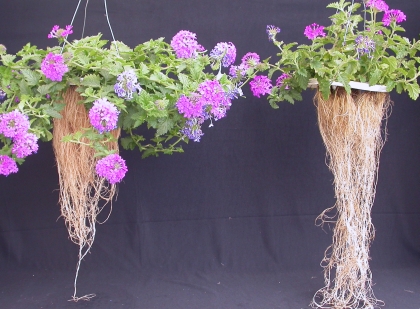Bet you weren’t expecting this on TUESDAY, eh?
Heh, heh.
Situation: these photos are from a grad student project. We wanted to create, observe, and record nutrient deficiency symptoms, so we grew the plants hydroponically in a made-from-scratch nutrient solution, containing everything except one particular nutrient. There were 12 separate batches of solution, one missing each essential mineral nutrient (N,P, K, Ca, Mg, S, Fe, Mn, Cu, B, Mo, Zn – couldn’t exclude Cl as it’s too common in salts). As my research interest is herbaceous perennials, some common perennial taxa served as our victims, er, subjects.
Here’s the set up for the Verbena ‘Homestead Purple’ experiment – rooted cuttings were placed in the little buckets and secured by the lids. The nutrient solution was constantly aerated. For most elements, symptoms appeared between two and four weeks after the start of the project. Symptoms, depending on the elemental deficiency, included chlorosis (yellowing) of old or new leaves, leaf curl, speckling, stunted growth, and in one case, some excessive growth.

Below are results from day 42 of the study. We lifted the lids, hanging-basket style, so we could examine the roots. The control (received a complete nutrient solution) is on the left; Rapunzel there, on the right, lacked a nutrient. Quiz question: What element was missing in this particular case? What made you come to this conclusion?
Hint: If you have a rudimentary knowledge of garden fertility, be it veggie or ornamental, you can probably figure this out. I’ll go ahead and rule out the pesky micronutrients.

(L) Control: received complete nutrient solution (R) Deficiency solution
Phosphorus because we all know P is important for building a strong (whatever that is) root system.
AAAAAAAAAARRRRRRGGGGGGHHHHH! (That’s for you, Bert!)
It’s got lots of roots and little top, so I’m going to go with nitrogen.
Nope,Ha!,and Nope.
Keep trying, people!
Zinc? If zinc helps regulate growth, and there is no regulation, does that mean that growth can go haywire? Or does that only work for crown growth, which looks a bit stunted here?
I can’t wait to hear the answer!
Calcium deficiency? Could explain the lack of lateral root branching…?
I’ll do a partial answer for now: Bert was right – Phosphorus – HOWEVER that was the MISSING element for the verbena plant on the right. And Deb was on the right track with the stunted top growth – a classic visual symptom of P deficiency. But anyone want to take a cr
ack at the root proliferation issue? Jeff? Linda?
This is quite interesting, given that people are told to load on the phosphorus to stimulate root growth (hence my reaction to Bert’s comment)! In field situations, low phosphorus plants are receptive to mycorrhizae infection, which increases the functional root mass of the plant and enhances both water and nutrient uptake. High phosphorus inhibits mycorrhizae, often to the plant’s detriment, and root growth usually increases to compensate for the lack of mycorrhizae. I don’t think I’ve ever seen increased root mass with -P (though to be honest it’s been 15 years since I did these same types of labs in my plant physiology class with sunflower plants). Does this happen every time you do the experiment?
Each taxa we studied did the same thing – Eliminating phosphorous resulted in root mass significantly greater than the control. I remember first learning that roots “mined” for P, then it was “no, they just proliferate in the presence of P”. Looks like they were “mining” to me!!
This is very intersting — I did some split-root experiments years ago where I would place half a root system in a solution of adequate P and the other half in lower P. As long as there was some P in the lower P solution we had decent root growth in that solution — but if the P was absent then all of the root growth was concentrated where there was P. Very, very interesting stuff. “Phosphorus grows roots” obviously isn’t as simple as we’d like to believe.